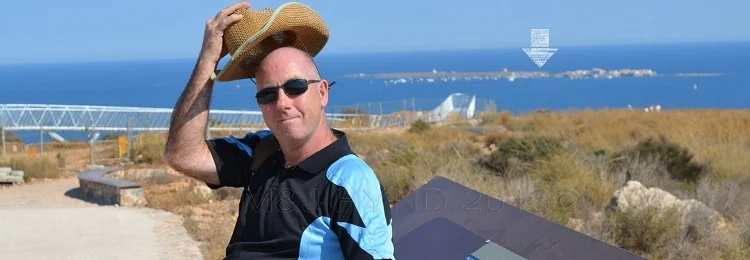Isla Tabarca, Spain
Typically, a Spanish holiday has water in the mix somewhere, as in on the coast, or on an island. There are two well-known groups of islands: the Balearics in the Mediterranean (e.g. Majorca) and the Canary Islands in the Atlantic just off the Western Sahara coast (e.g. Tenerife).
The drawback with an island is that once you’ve experienced it you’re a bit stuck, which is why a nice-to-have thought for Perleta Magic, was to have an offshore island close by - great for day-tripping, and watersports etc.
Yes, that would be tops; for us, and visitors. On holiday in this part of Spain many years ago, we were more than surprised to find the island of Tabarca (wiki), or Isla Tabarca, ticked all the right boxes, and only eight kilometres from Santa Pola which is just down the road from Perleta. Bingo! So it is ours(!).
Tabarca isn’t just any old block of rock in the sea as it comes complete with a well-fought over and unusual history. Before 1700, the island was known as Illa de Sant Pau , or 'Saint Paul's Island', as it was believed to be the island that St. Paul disembarked on. Plus, the island was a refuge for Barbary pirates up to the end of the 18th century.
Tabarca actually derives its name from an earlier part of Mediterranean history during the 1500’s, from Tabarka which is an island just off the mainland in Tunisia. Tabarka was originally populated with Genoese from Italy. When relations soured with the Arab rulers in the mid-1700’s, the Genoese relocated to Tabarca in Spain, and the name changed.
Tabarca is a nostalgic Spanish island hideaway. Barely two feet off the off the beaten track, it seems to be a location that time forgot, and the locals prefer it that way. The island has two faces; a walled town at the mainland end, and scrubby windswept land pointing east to the Mediterranean with a ruined fort at the highest point.
The traditional settlement remains largely unspoiled and unaffected by the growing number of visitors to Spain, who flock there during the summer months. The road surfaces anywhere on the island are not sealed, not even inside the walled town. Add in renovated houses alongside unrestored buildings and the town has a slightly surreal aura; I wouldn’t have been surprised to turn a corner and see two gun-slingers about to face off - it has that Sergio Leone feel about it. The only powered vehicles permitted are golf buggies which have been converted into small delivery trucks to take supplies to the bars, restaurants, hotels and superettes.
Old town wall... still standing.
Unpaved, and watch for Sergio Leone's ghost
There many ways to get across to Tabarca. The cheapest and most convenient is by ferry - it takes about 30 mins to get from Santa Pola marina to Tabarca. If you know a friend who's got a boat, all the better. For those who have just come to Spain for holidays perhaps you'd like to try a water taxi? Or you could charter a boat from the marina at Santa Pola and go deep-sea fishing.
A quick swim back to the mainland?
Crystal clear waters ...
And when you get to the island? Five minutes before the ferry reaches the jetty and moors, it stops and you'll see a myriad of colour as the fish comes darting and dashing for food as the bread is thrown overboard. It'll cause quite a stir, especially to the visitors from overseas, who have not been expecting this. The waters are crystal clear, and that's the moment to have your camera ready.
Main beach in the background.
Rush hour...
Tabarca is a protected marine reserve, aptly named the Reserva Marina de la Isla de Tabarca, declared a Zone of Special Protection for the Birds by the EU, with a varied marine fauna.
Tabarca was the last Spanish Mediterranean location where the endangered Mediterranean monk seal successfully bred before it became extinct in this part of its former distribution range. Therefore waters around Tabarca were declared a Marine reserve in 1986, the first of its kind in Spain. Hence the abundance of aquatic life around the shores - sport fishing is also prohibited.
Which in itself is a humorous juxtaposition: the fresh seafood restaurants on Tabarca are renowned, whilst residing in the middle of a marine reserve. A superb dish of grilled squid, fresh as can be, expertly prepared with delicate finesse... and it tastes divine.
You can hire a sun bed, or dive in the crystal clear waters. On a summers day, many water craft are moored there. Barbeque on board or seafood restaurant, take your pick. Pedalo boats pick their way alongside small sailing boats and dinghies moored in the half-moon bay that fronts the main beach harbour, with larger private yachts and million-Euro catamarans at anchor further out.
That's what a holiday will do, open your mind to the idea of future possibilities, not just in Spain but everywhere.








